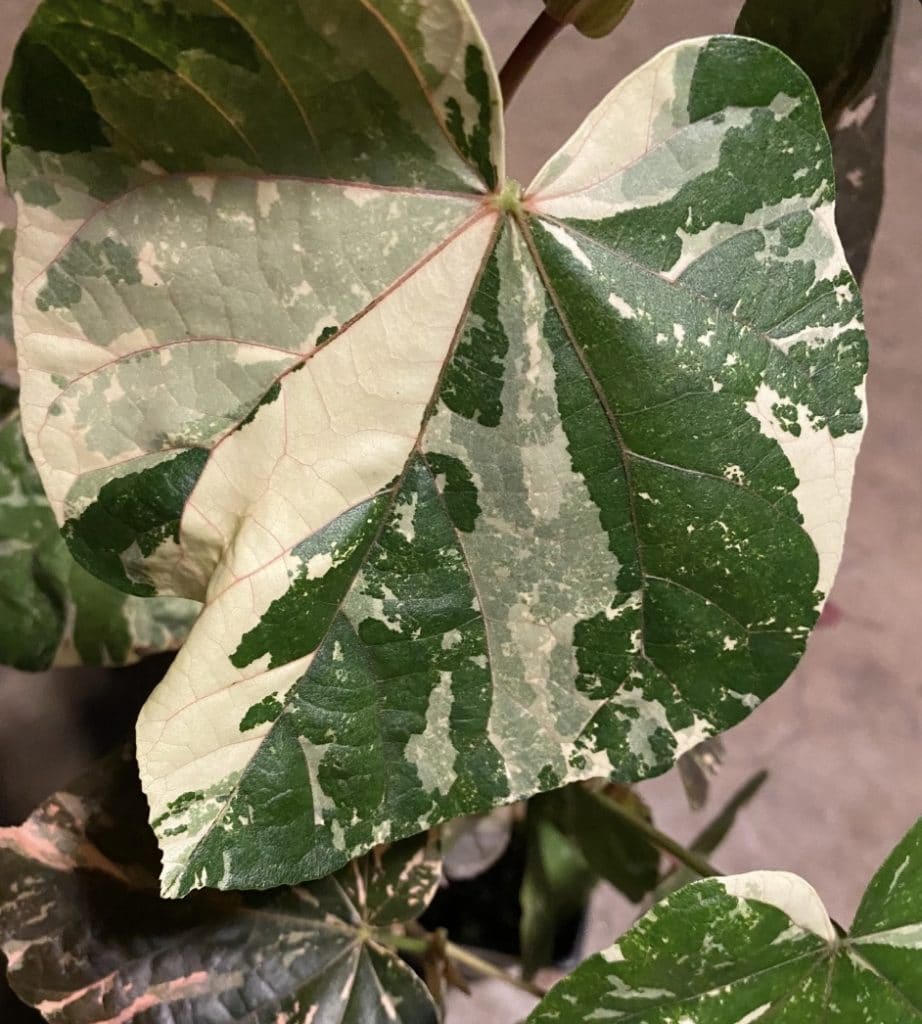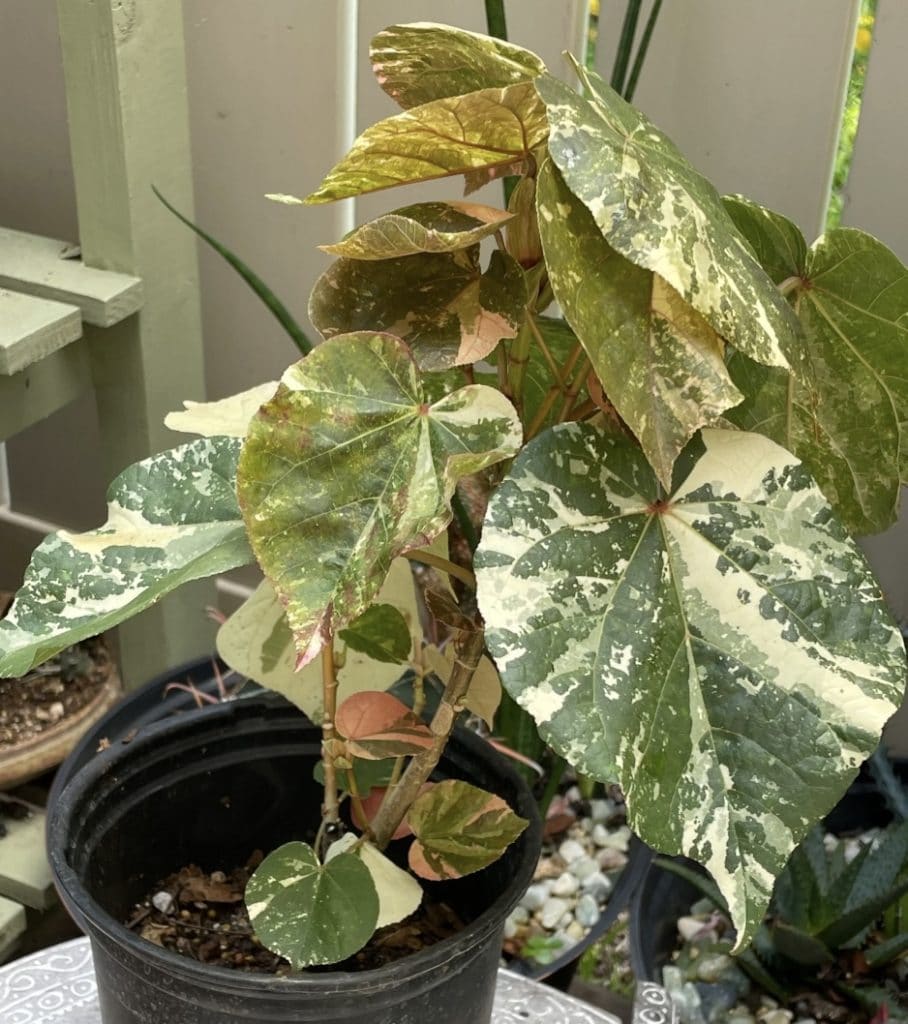Hibiscus Tiliaceus Variegata is a tropical plant with beautiful flowers and interesting leaves. It’s a shrub with upright growth in nature. Hibiscus tiliaceus is simple in its needs and can cope with direct and indirect sun, as well as some shade. The plants are pretty drought resistant as they originate from tropical and subtropical areas in Asia. Let’s look at how to grow and care for a Hibiscus Tillaceus Variegata.
What is a Hibiscus Tillaceus Variegata?
Hibiscus Tiliaceus Variegata is an ornamental plant with beautiful flowers that are yellow and maroon. It belongs to the family of Malvaceae and originates from Asia. Hibiscus tiliaceus can be found in various parts of Asia, like Pakistan, Sri Lanka, India, and Thailand, especially in coastal areas.
Hibiscus tiliaceus is an evergreen plant with variegated foliage that’s green and cream-colored. The leaves are large and heart-shaped and can grow up to 8 inches in length.
The plants are commonly referred to as Variegated sea hibiscus or coastal hibiscus. They can be grown in large containers, adding fertilizer twice a year (during spring and summer). Hibiscus Tiliaceus Variegata will be perfect on your patio garden in summer, but always remember to give some protection during very cold weather. It can be grown outside year-round in USDA zones 9b to 12.
Coastal hibiscus are fairly large shrubs that can grow up to 6 feet or more if well cared for in the correct climate.
How to Care for a Hibiscus Tillaceus Variegata
Hibiscus Tiliaceus Variegata is not very demanding in its needs. It can withstand bright indirect sun as well as shade but avoid full shade. These plants are tolerant to drought, but you should remember it’s a tropical plant and give the soil some water from time to time. Here are some tips to help you grow and care for a thriving Hibiscus Tiliaceus Variegata plant:
Sunlight Needs
Hibiscus Tiliaceus Variegata loves the sun, but it can also tolerate partial shade, especially in hot summer months. Remember that hibiscuses are tropical plants, and they will need at least 6 hours of daily sunlight if you want to have beautiful blooms. If you live in an area where summers are hot, give your plant some protection during afternoon hours by using a patio shade.
Watering Requirements
Hibiscus Tiliaceus Variegata is an easy-care plant that does not need much water. During the summer months, you will have to water your hibiscus daily or every other day, but during winter, you can reduce watering. If too much water accumulates around the plant’s roots, the plant will suffer from root rot and may die.
Temperature
If your climate usually produces mild winters without snow cover, make sure you protect your hibiscus as soon as the temperature drops close to freezing. You can overwinter your plant in a greenhouse or bring it into your home.
Fertilization
Hibiscuses are strong feeders, so always use organic fertilizer specially formulated for blooming plants. You can fertilize your plant once a month.
Soil
Hibiscus Tiliaceus Variegata needs well-drained, loose soil. The plant can be grown in regular potting soil, but a special mix for tropical plants is a better choice. If you have clay or sandy soil in your area, add some organic matter to balance it out. That being said, these plants are coastal hibiscus and can cope with sandier soils than other varieties. These plants like the soils pH range to be between 6.0 and 7.0, which is neutral or slightly acidic.
Pruning and Repotting
Hibiscus Tiliaceus Variegata blooms typically during spring and summer. Regular pruning (after flowering) is required to maintain the plant’s shape and size. The root system should be left intact because this plant will not survive if you uproot it every year or repot it frequently. If you live in an area where winters are harsh, consider overwintering your hibiscus inside the house.
Humidity
Hibiscus Tiliaceus Variegata can tolerate average humidity levels, but occasional misting will help the plant. Aim to create a humidity of around 50%.
Propagation
Hibiscuses are propagated by cutting off a stem with at least one leaf remaining. Let your cut end dry for about 1-2 days, and then pot it in moistened growing medium (peat and sand, or bark). If you want to root hibiscuses from cuttings during fall and winter, keep them inside a warm area where the temperature stays above 60F; otherwise, wait until springtime when conditions become more adequate.
Conclusion
Hibiscuses are beautiful flowering plants that need a sunny location and moist, well-drained soil. Hibiscus Tiliaceus Variegata is an easy-care plant that does not need much water, but it requires fertilization during spring and summer.
If you have clay or sandy soil in your area, add some organic matter to balance it out. In addition, regular pruning is required to maintain the plant’s shape and size. Hibiscuses are propagated by cutting off a stem with at least one leaf remaining after flowering has finished. This plant can be overwintered inside the house or moved to a greenhouse for cold months.
Related: Fort Myers Hibiscus

